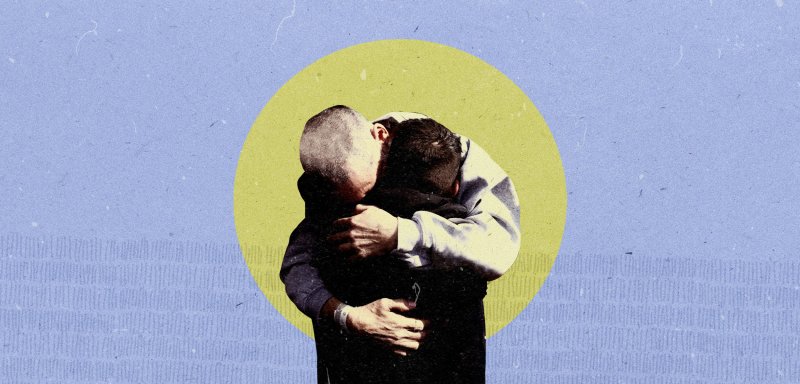In late January, Israel released over 200 Palestinian prisoners—some of whom were women and children held without formal charges—in return for only four female soldiers, all of whom were escorted, on stage, by Hamas members.
“The issue here is that the world has gotten so used to dehumanizing Palestinians that they don't even bat an eye when they hear numbers like 200,” Diana Buttu, a Palestinian lawyer based in Haifa, tells Raseef22. “They don't even think twice to question the system of mass incarceration that Israel has put into place.”
In another exchange on February 8th, Israel released more than 183 Palestinian prisoners in exchange for 3 hostages.
In the theater of conflict, the release of hostages becomes a telling performance on the world stage. While the act is often framed as a humanitarian gesture, the mechanics of these hostage exchanges between Israel and Hamas put a spotlight on the stark disparity in how lives are valued. When Palestinian prisoners are released, the act is swift. Emerging from vehicles with blacked-out windows, the hundreds of oft-unnamed men, women and children embrace their loved ones in a flurry of tattered grey prison garb. No stage is needed for the cast members of Israel’s rolling prison system. Israeli hostages are named, while the identities of the dozens of Palestinians remain largely awash with obscurity. This sheer numerical imbalance prompts critical examination from experts on the under-handed dehumanization of Palestinians and the broader asymmetries in how these negotiations are portrayed by governments and the media.
“The issue here is that the world has gotten so used to dehumanizing Palestinians that they don't even bat an eye when they hear numbers like 200,” Diana Buttu, a Palestinian lawyer based in Haifa, tells Raseef22. “They don't even think twice to question the system of mass incarceration that Israel has put into place.”
“This partly reflects the fact that, of course, Israel holds many, many more Palestinian prisoners of various kinds than Palestinian forces do,” says Zachary Lockman, Professor of Modern Middle East History at New York University. “ This puts Palestinian groups, including Hamas, in a position to negotiate and demand a much larger number of Palestinians in return for a smaller number of Israeli hostages.”
Media coverage plays a pivotal role in shaping public perception of these exchanges. Israeli hostages, such as Arbel Yehoud, are often depicted as symbols of national resilience and unity. Their stories receive extensive coverage, highlighting their personal backgrounds and the national efforts undertaken to secure their release. In contrast, the narratives of Palestinian detainees and their families receive comparatively little attention.
“They're trying to drive home the message of superiority… and that's what all of this; the caloric control [of Palestinian prisoners] has been about showing who's boss,” Buttu says. This disparity in coverage contributes to a one-sided narrative that emphasizes Israeli suffering while minimizing Palestinian dehumanization.
During recent exchanges, Hamas orchestrated the handover of hostages in a manner designed to highlight their control and magnanimity. “ Hamas has long known a thing or two about PR,” Lockman says. “The fact that they can stage these events, bring people back out into the streets, and show that there are lots of armed militants there in uniform appearing in public in these hostage transfers—it’s a way to say, ‘we are still here, we're still fighting. We have not been defeated.’”
It isn’t just a simple PR stunt for the group—Hamas needs the leverage now more than ever. “ Hamas and the Palestinians in general don't have the tanks, the aircrafts, helicopters, guns, ships and all the rest,” Lockman says. “So seizing Israelis to trade for Palestinian prisoners—which again is an enormously powerful issue in the Palestinian community—gives them some bargaining power which otherwise they don't really have.” These displays are also intended to bolster their standing among supporters and legitimize their actions on the international stage.
Conversely, Israel tends to minimize the exposure of Palestinian prisoners during exchanges. The identities of released individuals are often withheld, and media coverage is limited. This approach serves multiple purposes: it reduces the risk of released individuals becoming celebrated figures who could inspire further dissent, and it maintains a focus on Israeli narratives of victimhood and resilience. By controlling the visibility of Palestinian prisoners, Israel aims to prevent them from being used as propaganda tools or martyrs.
This use of propaganda in order to sway public opinion oscillates between the two groups. At the start of the genocide, Buttu notes, the Israelis amplified a slogan: yachad ninatze'ach—together, we will succeed. The latter word in Hebrew aligns with a specific verb for “victory.” On the stage, during the hostage swap for the four female captives, the slogan was rebutted by Hamas using the same verb: “[Nazi] Zionism will never succeed.”
“The message was a very specific, deliberate one to the Israelis,” Buttu points out, pulling three meanings from Hamas’s messaging during the on-stage swaps. “One, to show that [Hamas] has control. Two, to show that the Israelis were treated well, and, three, that they're poking at the Israeli psyche.”
The messaging from Israel is equally deliberate and nuanced in its approach—sometimes in subtle ways, sometimes more egregious. “There are visible signs of abuse and torture on [the Palestinians],” Buttu says. The blacked-out windows of the vehicles dropping off prisoners prevent the media from taking their photos from behind the glass. They sometimes drop off the prisoners in the dark of night, Buttu adds, forcing families to wait for hours in the cold. “Here's the Israelis sending a message to Palestinians: ‘You're not allowed to be happy. We're going to control it… We can even control the timing, the manner, and every element of your existence.’ They're trying to drive home the message of superiority.”
Israel tends to minimize the exposure of Palestinian prisoners during exchanges. The identities of released individuals are often withheld, and media coverage is limited. This approach serves multiple purposes: it reduces the risk of released individuals becoming celebrated figures who could inspire further dissent, and it maintains a focus on Israeli narratives of victimhood and resilience.
The political motivations underlying these exchanges are complex but chronicled. “ There's a history to this going back at least to 2011,” Lockman notes, “when Gilad Shalit, an Israeli soldier who'd been captured by Hamas on the Gaza Israel border, was exchanged for over a thousand Palestinian prisoners.” The exchange Lockman referenced was regarded as “the most lopsided prisoner swap in Israel's history.”
For Israel, securing the release of its citizens serves to bolster national morale and demonstrate the government's commitment to its people. However, by agreeing to release a large number of Palestinian prisoners, many of whom have not been charged with any crime, Israel inadvertently acknowledges the contentious nature of its detention practices.
Hamas, on the other hand, utilizes these exchanges to gain political leverage and legitimacy that they otherwise struggle to maintain, especially as a designated foreign terrorist organization by the United States. By securing the release of Palestinian prisoners, especially women and children, Hamas aims to position itself as a defender of Palestinian rights and a formidable negotiator against Israel. “ That bolsters standing at horrific cost, obviously,” Lockman says, “but the fact that they've been able to achieve this allows them to point to it… as a success as a result of this war. Whether Palestinians will ultimately decide if the price was worth it will be something for the longer term to determine.”
Many of the exchanged and negotiated Palestinian detainees had been held in administrative detention without formal charges, a practice that has drawn international criticism. “There's hardly a family in the West Bank or Gaza who doesn't have somebody who has been in prison or is in prison,” says Lockman. In the occupied Palestinian territories, one in every five Palestinians has been arrested and charged at some point—a rate that doubles for Palestinian men. The practice not only violates international legal standards, but may also perpetuate a narrative that Palestinian lives are inherently suspect. This raises questions about the perceived value of both Palestinian and Israeli lives in the context of these negotiations—Palestinians are dubbed “prisoners,” but many have never gone through trial.
Among those released in the recent swaps were individuals like Jamal al-Tawil, a prominent Hamas politician detained without trial since 2021. While the release was celebrated by Palestinian communities, it also highlighted the arbitrary nature of Israel’s detention policies. For families of detainees, the uncertainty and anguish of not knowing when—or if—their loved ones will be released is a form of psychological torture.
By agreeing to release a large number of Palestinian prisoners, many of whom have not been charged with any crime, Israel inadvertently acknowledges the contentious nature of its detention practices.
In the occupied Palestinian territories, Israeli military commanders have the authority to detain Palestinian civilians without charge or trial under Article 285 of Military Order 1651. This allows for initial detention periods of up to six months, which can be renewed indefinitely if there are "reasonable grounds to presume that the security of the area or public security require the detention." These grounds are not specifically defined. “ Many of these people are in prison for many years,” Lockman notes, “in some cases decades, for engaging in resistance to an occupation, which is legal under international law.”
The fact that many Palestinian detainees are held without charges underscores a systematic issue within the Israeli justice system. The numerical imbalance in the exchanges, coupled with the media's differential treatment of Israeli and Palestinian narratives, highlights systemic issues of dehumanization and bias.
Israeli military commanders have the authority to detain Palestinian civilians without charge or trial under Article 285 of Military Order 1651. This allows for initial detention periods of up to six months, which can be renewed indefinitely if there are "reasonable grounds to presume that the security of the area or public security require the detention." These grounds are not specifically defined.
“We live in a world where it really doesn't matter what the thinking in most of the countries of the world is. What matters is the power of the United States, which has been happy to ignore international laws and ignore any reasonable standard of decency,” Lockman concludes.
“I think the vast bulk of the international community has been horrified at what's gone on in Gaza and is at least open to the idea that Israel has committed genocide or violated the laws of war, at a minimum translating that into effective pressure on Israel to change policy and to achieve some measure of Palestinian rights… we're still a very long way off from that.”
Raseef22 is a not for profit entity. Our focus is on quality journalism. Every contribution to the NasRaseef membership goes directly towards journalism production. We stand independent, not accepting corporate sponsorships, sponsored content or political funding.
Support our mission to keep Raseef22 available to all readers by clicking here!
Interested in writing with us? Check our pitch process here!



